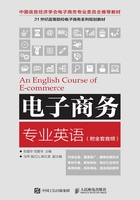
Unit 1
Text A Types of Electronic Business
Electronic Business, commonly referred to as “eBusiness” or “e-business”, may be defined as the utilization of information and communication technologies (ICT) in support of all the activities of business. Commerce constitutes the exchange of products and services between businesses, groups and individuals and hence can be seen as one of the essential activities of any business. Hence, electronic commerce or e-commerce focuses on the use of ICT to enable the external activities and relationships of the business with individuals, groups and other businesses.
Louis Gerstner, the former CEO of IBM, in his book, Who Says Elephants Can’t Dance? attributes the term “e-business” to IBM’s marketing and Internet teams in 1996.
Electronic business methods enable companies to link their internal and external data processing systems more efficiently and flexibly, to work more closely with suppliers and partners, and to better satisfy the needs and expectations of their customers.
In practice, e-business is more than just e-commerce. While e-business refers to more strategic focus with an emphasis on the functions that occur using electronic capabilities, e-commerce is a subset of an overall e-business strategy. E-commerce seeks to add revenue streams using the World Wide Web or the Internet to build and enhance relationships with clients and partners. Often, e-commerce involves the application of knowledge management systems.
E-business involves business processes spanning the entire value chain:electronic purchasing and supply chain management, processing orders electronically, handling customer service, and cooperating withbusiness partners. Special technical standardsfor e-business facilitate the exchange of data between companies. E-business software solutions allow the integration of intra and inter firm business processes. E-business can be conducted using the Web, the Internet, intranets, extranets, or some combination of these.
1. Business-to-Business
Business-to-Business (B2B)is a term commonly used to describe commerce transactions between businesses like the one between a manufacturer and a wholesaler or a wholesaler and a retailer, i.e., both the buyer and the seller are business entity. This is unlike Business-to-Consumer (B2C) which involves a business entity and end consumer, or Business-to-Government (B2G)which involves a business entity and government.
The volume of B2B transactions is much higher than the volume of B2C transactions. The primary reason for this is that in a typical supply chain there will be many B2B transactions involving subcomponent or raw materials, and only one B2C transaction, specifically sale of the finished product to the end customer. For example, an automobile manufacturer makes several B2B transactions such as buying tires, glass for windshields, and rubber hoses for its vehicles. The final transaction, a finished vehicle sold to the consumer, is a single (B2C) transaction.
2. Business-to-Consumer
Business-to-Consumer (B2C) describes activities of businesses serving end consumers with products and/or services.
An example of a B2C transaction would be a person buying a pair of shoes from a retailer. The transactions that lead to the shoes being available for purchase, which is the purchase of the leather, laces, rubber, etc. as well as the sale of the shoes from the shoemaker to the retailer, will be considered (B2B) transactions.
3. Business-to-Employee
Business-to-Employee (B2E) electronic commerce uses an intrabusiness network which allows companies to provide products and/or services to their employees. Typically, companies use B2E networks to automate employee-related corporate processes.
Examples of B2E applications include:
• Online insurance policy management
• Corporate announcement dissemination
• Online supply requests
• Special employee offers
• Employee benefits reporting
• Special discounts to employees
4. Business-to-Government
Business-to-Government (B2G) is a derivative of B2B marketing and often referred to as a market definition of “public sector marketing”. It encompasses marketing products and services to government agencies through integrated marketing communications techniques such as strategic public relations, branding, advertising, and Web-based communications.
5. Government-to-Business
Government-to-Business (G2B) is the online non-commercial interaction between local and central government and the commercial business sector, rather than private individuals. For example, http://www.dti.gov.uk is a government website where businesses can get information and advice on e-business “best practice”.
6. Government-to-Government
Government-to-Government (G2G) is the online non-commercial interaction between government organizations, departments, and authorities and other government organizations, departments, and authorities. Its use is common in the UK, along with G2C, the online non-commercial interaction of local and central government and private individuals, and G2B, the online non-commercial interaction of local and central government and the commercial business sector.
G2G systems generally come in one of two types:
• Internal facing—joining up a single governments departments, agencies, organizations and authorities—examples include the integration aspect of the Government Gateway, and the UK NHS Connecting for Health Data SPINE.
• External facing—joining up multiple governments is systems—an example would include the integration aspect of the Schengen Information System (SIS), developed to meet the requirements of the Schengen Agreement.
7. Consumer-to-Consumer
Consumer-to-Consumer (C2C) involves the electronically-facilitated transactions between consumers through some third party. A common example is the online auction, in which a consumer posts an item for sale and other consumers bid to purchase it; the third party generally charges a flat fee or commission. The sites are only intermediaries, just there to match consumers. They do not have to check quality of the products being offered.
7.1 Examples of C2C
• eBay
• Craigslist
• Amazon.com
This type of e-commerce is expected to increase in the future because it cuts out the costs of using another company. However it has the following problems:
• No quality control
• No payment guarantee
• Hard to pay for using cheques, ATM cards, etc. but in the future this is likely to change
7.2 Universities
C2C are becoming more popular among students in universities because these are large communities in the same geographical region that are low on money.So they are looking for deals very often and these kinds of websites offer this. Universities themselves set up places for students to sell textbooks and other stuff to other students; you can even advertise that you are subletting your apartment.